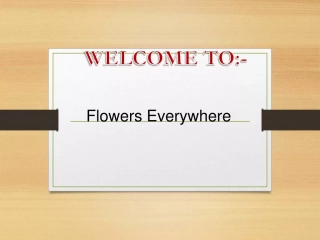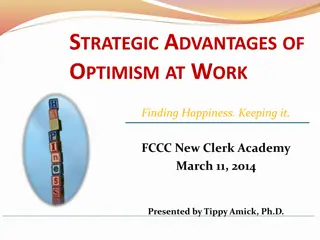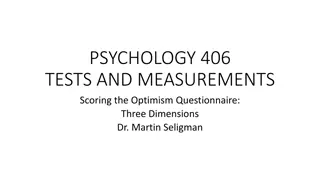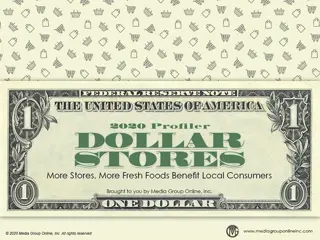Florists Market Insights: Challenges and Optimism Amid Sales Decreases
Recent data from the US Bureau of Economic Analysis shows significant decreases in florists' sales, with a 19.8% drop in 2018. Despite this, florists remain optimistic about future market growth, particularly with the forecasted $16 billion floral gifting market by 2023. The upcoming holiday season could be a boost for florists, with positive trends seen in previous years. Wholesalers also reported upbeat performance for Mother's Day 2019, highlighting challenges such as freight charges. Despite the challenges, there are more opportunities for savvy florists to thrive in the market.
Uploaded on Sep 17, 2024 | 1 Views
Download Presentation

Please find below an Image/Link to download the presentation.
The content on the website is provided AS IS for your information and personal use only. It may not be sold, licensed, or shared on other websites without obtaining consent from the author.If you encounter any issues during the download, it is possible that the publisher has removed the file from their server.
You are allowed to download the files provided on this website for personal or commercial use, subject to the condition that they are used lawfully. All files are the property of their respective owners.
The content on the website is provided AS IS for your information and personal use only. It may not be sold, licensed, or shared on other websites without obtaining consent from the author.
E N D
Presentation Transcript
Significant Decreases in Florists Sales Recent data from the US Bureau of Economic Analysis (BEA) is not good news for florists, as 2018 s total sales of $5.4 billion was a 19.8% decrease from 2017. Through the first half of 2019, however, the news was somewhat better, but the florists sector was still reporting red numbers. Total 1H 2019 sales were $2.63 billion, a 6.1% decrease from 1H 2018 s $2.8 billion. Another measure of the floral market is the BEA s data on personal consumption expenditures for flower, seeds and potted plants. The SAAR (seasonally adjusted annual rate) for 1H 2019 was 2.4% better ($34.4 billion) than 1H 2018.
Florists Remain Optimistic About Future Market Growth The US floral gifting market is forecast to total $16 billion by 2023, increasing at a CAGR (compound annual growth rate) of approximately 6% during the 2018 2023 period, but supermarkets and similar outlets account for approximately 50% of the market. The grocery sector is doing so well with floral sales that many are introducing studio florists and expanding to a more complete in-store service and some chains are even assessing the value of growing the flowers they sell in-store. Despite the sales decreases for florists, 50% of those who responded to a July 2019 survey from the Society of American Florists (SAF) said their business was good ; 12%, excellent ; and 33%, OK.
Holidays 2019 Could Be Good for Florists Again According to a post-holidays 2018 SAF survey, 60% of responding florists said their December 2018 sales increased, with 29% reporting a 1 5% increase and 24% a 6 10% increase. Last year s positive performance may bode well for the 2019 holiday season. Although the National Retail Federation forecasts a 3.8% to 4.2% increase in 2019 holiday season sales, there will be 6 fewer shopping days because of a late Thanksgiving. Florists and other floral market outlets must be prepared to increase inventory earlier as many consumers will start shopping earlier, utilize more use of mobile advertising to attract young consumers and highlight holiday trends in- store and online.
Wholesalers Upbeat with Mother s Day 2019 Performance Mother s Day 2019 floral sales were better than expected for 29.7% of the respondents (76% were wholesalers) to a Wholesale Florist & Florist Supply Association survey, with 48.7% as expected and 21.6% less than expected. Freight charges continue to be a major challenge for floral wholesalers, as 32.4% answered the survey, much higher this year ; 35.1%, a bit higher ; and 29.7%, approximately the same. Wholesalers were quite pleased with the quality of Mother s Day flowers, with 37.1% very satisfied and 42.9% satisfied. Flower prices increased for 57.9% of respondents, decreased for just 5.3% and were flat for 29.0%.
More Opportunities for the Savvy Florist Relieving stress is one of the floral market s primary value propositions, as a 2018 University of North Florida study found a 5.5 point decrease in stress among the women participating in the study who received and lived with flowers. The drivers of the floral market s increase to $17 billion by 2023 include Baby Boomers purchasing more bouquets, appealing to the growing multicultural audiences, an increased interest in floral subscription services and addressing sustainability. Florists who are savvy about current trends have an advantage. For example, all the standard holiday trends pinecones and green, red and gold will dominate the 2019 holidays, but blue will be a new color trend.
Advertising Strategies Television should be a valuable ad medium for florists, especially to promote the purchase of bouquets among Baby Boomers. Smaller florists who may not have a budget for traditional TV advertising may find success with ads on your station s Website. Florists also have an opportunity with multicultural audiences by offering plants and arrangements that are traditional to those cultures and featuring them in advertising during the months officially designated to honor those cultures. (See Calendar of Events.) Florists can also emphasize the health benefits of receiving and living with flowers as noted at the top of page 3 of the Profiler by creating and featuring arrangements and other floral products that have specific properties for relieving stress and other ailments.
New Media Strategies Social media provides florists with many opportunities to share stories about why they became florists, the special skills of employees and environmental/sustainability efforts of wholesalers and florists restricting their wholesale purchases to those vendors. A regular presence in the mobile channel is essential to attract younger consumers. Text-messaging advertising works well to feature a particular arrangements or other floral products at special prices. Use social media to promote and collect donations to create and deliver free floral arrangements to low-income, assisted-living facilities, providing residents with opportunities to enjoy flowers, which they might not otherwise be able to afford.























